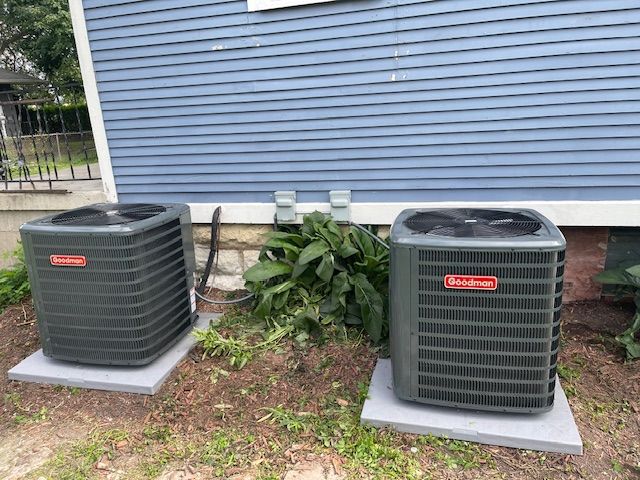HVAC tune-ups in Streamwood, IL from Amazing Air INC. offer a comprehensive, safety-focused service that keeps heating and cooling systems running efficiently through seasonal extremes. The visit includes a structured checklist, thermostat calibration, burner and heat exchanger checks, refrigerant and airflow verification, duct inspection, lubrication, electrical testing, and performance verification. Benefits include higher efficiency, fewer emergency repairs, longer equipment life, improved comfort, preserved warranties, and minimized midseason disruptions. Schedule a tune-up with Amazing Air INC. to ensure reliable operation and peak readiness for fall and spring.

HVAC Tune-Up in Streamwood, IL
A professional HVAC tune-up in Streamwood, IL keeps your heating and cooling systems running safely, efficiently, and reliably through cold winters and humid summers. Regular tune-ups prevent unexpected breakdowns during peak weather, help control energy costs, and address common issues that affect older suburban homes in the Streamwood area—from furnace strain after long heating seasons to air conditioner performance loss from pollen and road dust buildup.
Common HVAC tune-up issues in Streamwood, IL
- Furnace short cycling or slow starts after extended idle periods in late fall
- Reduced cooling capacity and higher energy use on hot, humid days
- Thermostat miscalibration causing inconsistent indoor temperatures
- Dirty coils, clogged condensate drains, and restricted airflow from seasonal debris
- Refrigerant leaks or low charge that reduce cooling efficiency
- Cracked heat exchangers or burner problems in older furnaces that create safety risks
- Duct leaks, poor insulation, and dirty returns common in older construction
- Frozen evaporator coils after spring startup when airflow is inadequate
What a complete HVAC tune-up includes
A thorough tune-up follows a structured checklist to inspect, test, clean, and adjust critical components. Typical items covered:
- Safety inspection
- Visual and functional checks for gas leaks, proper venting, combustion stability, and carbon monoxide risks
- Verification of safety switches, limit controls, and flue integrity on furnaces and boilers
- Thermostat calibration
- Verify set points and sensor accuracy
- Recalibrate or recommend replacement for inconsistent temperature control
- Burner and heat exchanger checks (furnaces and boilers)
- Inspect burner flame pattern and ignition components
- Examine heat exchanger for cracks or corrosion that can affect safety and efficiency
- Refrigerant and pressure checks (air conditioners and heat pumps)
- Measure refrigerant pressures and temperatures to confirm correct charge
- Scan for signs of leaks and assess system pressures under load
- Airflow and duct inspection
- Inspect filters, blower assembly, return ducts, and supply registers
- Check static pressure and airflow balance; note leaks, disconnected ducts, or insulation gaps
- Lubrication and cleaning
- Clean evaporator and condenser coils as needed to restore heat transfer
- Lubricate motors and moving parts where applicable, and clean condensate drain and pan to prevent clogs
- Electrical and control system checks
- Tighten electrical connections, check capacitors and contactors, and measure motor amperage
- Confirm safe operation of relays, control boards, and safety interlocks
- Performance verification
- Measure temperature split, system runtime, and operational noise
- Provide a summary of findings and recommendations for repairs or efficiency improvements
The diagnostic process — what happens during the visit
Technicians use a methodical approach: initial system assessment, baseline measurements, targeted inspections, cleaning and adjustments, then final performance testing. They typically:
- Shut down and secure the system
- Record baseline temperatures, pressures, and electrical readings
- Inspect and test combustion and safety systems (for gas equipment)
- Clean coils, filters, and drain lines; adjust blower speeds and damper positions if needed
- Re-measure performance under normal operating conditions and document results
Most single-system tune-ups take about 60 to 90 minutes. Older systems, multi-zone installations, or combined furnace and AC visits may require 90 to 120 minutes or more depending on condition and findings.
Performance, safety, and longevity benefits
- Improved efficiency and lower monthly energy use through clean coils, correct refrigerant charge, and optimized airflow
- Fewer emergency repairs by catching worn parts, leaks, or electrical issues before failure
- Longer equipment life from regular lubrication, cleaning, and adjustments
- Enhanced comfort with better temperature balance, reliable startup, and fewer short cycles
- Reduced safety risks by verifying combustion stability, venting, and carbon monoxide protections
- Help maintaining manufacturer warranties when routine maintenance is documented
Why tune-ups are especially relevant in Streamwood
Streamwood sees wide seasonal swings—from cold, extended heating seasons to hot, humid summers. Freeze-thaw cycles, winter road salt, and spring pollen contribute to system stress and debris buildup. Homes that are tightly sealed for winter can also concentrate indoor pollutants, making HVAC system performance and filtration more important. Regular tune-ups timed for fall heating startup and spring cooling startup minimize seasonal failures and often reduce wait times during busy weather transitions.
Maintenance plans and tune-up packages
Homeowners commonly choose annual service plans that bundle seasonal inspections, priority scheduling, and documented maintenance records. Typical plan benefits include at least one furnace inspection before winter and one AC tune-up before summer, routine filter reminders, and scheduled safety checks. These structured plans help preserve system performance and provide predictable maintenance intervals.
Preparing for a tune-up and scheduling guidance
- Clear access to the furnace/air handler and outdoor condensing unit
- Note any recent issues (noise, odors, uneven heating/cooling) and have the thermostat settings ready
- Locate past service records if available for reference
- Recommended frequency: at least one annual tune-up per system; two visits per year if you rely heavily on both heating and cooling
Regular HVAC tune-ups in Streamwood, IL deliver measurable benefits in safety, comfort, and system longevity. Scheduling preventive maintenance during shoulder seasons—fall for furnaces and spring for air conditioners—aligns service with peak readiness and helps avoid midseason disruptions.
Customer Testimonials
Exceptional service and professionalism, exceeding expectations every time.
Service Areas



